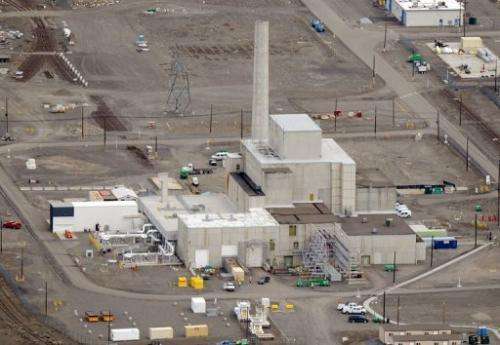Cleanup operations at the Western hemisphere's most contaminated nuclear site in Hanford, Washington, March 21, 2011. Heightened radioactivity levels were found outside a nuclear waste tank in Washington, officials said Friday, in a new alert about a site used to make Cold War-era bombs.
Heightened radioactivity levels were found outside a nuclear waste tank in the US state of Washington, officials said Friday, in a new alert about a site used to make Cold War-era bombs.
Governor Jay Inslee said there was no immediate public health threat, but urged federal authorities to accelerate action to deal with leaks at the Hanford site, which he sounded the alarm about four months ago.
In February, Inslee said that at least six tanks containing radioactive waste were leaking, based on decreasing levels within them, but no elevated radioactivity levels were recorded outside of the containers themselves.
Now, higher radiation levels have been recorded in a pit next to a double-shell tank at the the site, he said—suggesting that waste material has leaked through both shells containing them.
Inslee said that federal experts "discovered what appears to be an elevated contamination level reading in the leak detection pit outside and adjacent to the Hanford double-shell tank AY-102."
"This is most disturbing news for Washington. It is not clear yet whether that contamination is coming directly from the outer shell of the AY-102 but it must be treated with the utmost seriousness," he said.
The Hanford nuclear site, 185 miles (300 kilometers) southeast of Seattle, was used to produce plutonium for the bomb that brought an end to World War II.
Output grew after 1945 to meet the challenges of the Cold War, but the last reactor closed down in 1987.
"Weapons production processes left solid and liquid wastes that posed a risk to the local environment," its website said.
Millions of gallons of leftover waste are contained in 177 tanks at the site, according to the Energy Department, which in 1989 inked a deal with Washington state authorities to clean up the Hanford Site.
Inslee said he was told about the raised radiation levels by US Energy Secretary Ernest Moniz, who called him Thursday night.
"I told the secretary I continue to have serious concerns regarding the pace of addressing the leaking tanks. We will be insisting on an acceleration of remediation of all the tanks, not just AY-102," Insleed said in a statement.
The Energy Department "has a legal obligation to clean up Hanford and remove or treat that waste, and we ensure that legal obligation is fulfilled."
A spokeswoman for Washington state's Ecology Department explained why the new finding was so disturbing.
"Until last night, it was thought the leak was contained in the outer shell, but workers detected elevated radioactivity levels within the leak detection pit," Erica Holmes told AFP.
© 2013 AFP




















